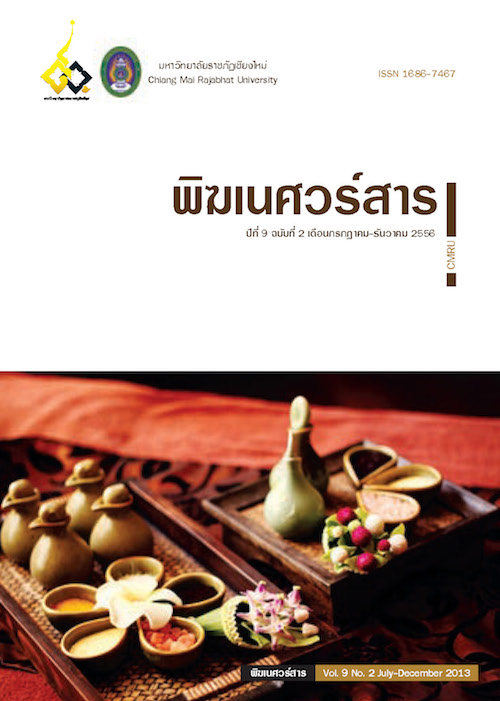การศึกษาการป้องกันและควบคุมโรคที่เกิดจากการขาดสารไอโอดีน ของนักเรียนในอำเภอกัลยาณิวัฒนา จังหวัดเชียงใหม่
Main Article Content
Abstract
การวิจัยเชิงพรรณนานี้มีวัตถุประสงค์เพื่อศึกษาสถานการณ์การขาดสารไอโอดีนของเด็กนักเรียนและหาความสัมพันธ์ของการรับรู้ของผู้ปกครองเด็กนักเรียนกับปริมาณไอโอดีนในปัสสาวะของเด็กนักเรียนในอำเภอกัลยาณิวัฒนา จังหวัดเชียงใหม่ โดยประยุกต์แนวคิดทฤษฎีความเชื่อ ด้านสุขภาพ กลุ่มตัวอย่างเป็นเด็กนักเรียนที่ได้รับการตรวจหาปริมาณไอโอดีนในปัสสาวะและผู้ปกครองของเด็กนักเรียน จำนวน 171 คน เลือกโดยการสุ่มตัวอย่างแบบมีระบบ เก็บข้อมูลโดยใช้แบบสัมภาษณ์ วิเคราะห์ข้อมูลโดยใช้สถิติพรรณนา สัมประสิทธ์สหสัมพันธ์ของเพียร์สัน และไคสแควร์ พบว่า
ผู้ตอบแบบสอบถามซึ่งเป็นผู้ปกครองนักเรียนกลุ่มตัวอย่างส่วนใหญ่ เป็นชาย มีอายุระหว่าง51-60 ปี อาชีพเกษตรกรรม มีรายได้ต่ำกว่า 3,000 บาท ร้อยละ 37.4 เคยได้รับข้อมูลข่าวสารและคำแนะนำเกี่ยวกับคอพอก ร้อยละ 86.5 โดยส่วนใหญ่ได้รับคำแนะนำจากเจ้าหน้าที่สาธารณสุขจากสื่อวิทยุ โทรทัศน์ หนังสือพิมพ์ ร้อยละ 15.8 ผลการตรวจสารไอโอดีนในปัสสาวะของเด็กนักเรียนที่เป็นกลุ่มตัวอย่าง พบว่ามากกว่า 100 ไมโครกรัมต่อลิตร ร้อยละ 52.0 50-100 ไมโครกรัมต่อลิตร ร้อยละ 35.7 และมีค่าน้อยกว่า 50 ไมโครกรัมต่อลิตร (ต่ำกว่าปกติ) ร้อยละ 12.3 การรับรู้ความเสี่ยงต่อการขาดสารไอโอดีน อยู่ในระดับสูง ได้แก่ การรับประทานอาหารทะเล การรับประทานอาหารที่ใช้เกลือผสมไอโอดีนปรุง รับรู้ความรุนแรงของการขาดสารไอโอดีนอยู่ในระดับสูง ได้แก่ ทำให้เป็นคอพอก มีพัฒนาการไม่สมวัย สติปัญญาล่าช้า ร่างกายจะเตี้ยแคระแกร็น การรับรู้ประโยชน์ของสารไอโอดีน อยู่ในระดับสูง ในด้านการใช้ผลิตภัณฑ์ปรุงรสที่มีส่วนผสมของไอโอดีน การรับประทานอาหารทะเลที่สามารถป้องกันโรคขาดสารไอโอดีนได้การรับรู้อุปสรรคต่อการได้รับสารไอโอดีน อยู่ในระดับปานกลาง โดยการหาซื้ออาหารทะเลการดื่มน้ำที่ผสมไอโอดีนเป็นประจำ เป็นอุปสรรคมาก พฤติกรรมการป้องกันโรคขาดสารไอโอดีนของกลุ่มตัวอย่างที่ปฏิบัติเป็นประจำ ได้แก ่ ซื้อหรือทานอาหารที่ใช้เกลือเสริมไอโอดีน ร้อยละ25.1 รับประทานอาหารทะเล ร้อยละ 24.6 และใช้เกลือผสมไอโอดีน ร้อยละ 22.2
ความสัมพันธ์ระหว่างปัจจัย พบว่า ปัจจัยด้านการรับรู้ความเสี่ยงต่อการเกิดโรคขาดสารไอโอดีนไม่มีความสัมพันธ์กับพฤติกรรมการควบคุมป้องกันโรคและความรุนแรงของโรคโดยรวม แต่พบว่าการรับรู้อุปสรรคในการป้องกันการเกิดโรคขาดสารไอโอดีน มีความสัมพันธ์เชิงลบกับการรับประทานอาหารทะเลอย่างมีนัยสำคัญทางสถิติ ที่ระดับ .01 ปัจจัยด้านการรับรู้ประโยชน์ของการป้องกันโรคขาดสารไอโอดีนมีความสัมพันธ์กับการใช้เกลือเสริมไอโอดีนอย่างมีนัยสำคัญทางสถิติที่ระดับ .01 ปัจจัยทางสังคม ด้านอาชีพ และรายได้ มีความสัมพันธ์กับพฤติกรรมการควบคุมป้องกันโรคขาดสารไอโอดีนอย่างมีนัยสำคัญทางสถิติที่ระดับ .05 ปัจจัยทางสังคม ได้แก่ รายได้และการได้รับคำแนะนำเกี่ยวกับไอโอดีน มีความสัมพันธ์กับระดับไอโอดีนในปัสสาวะของกลุ่มตัวอย่าง อย่างมีนัยสำคัญทางสถิติ ที่ระดับ .01 และ .05
ผลการวิจัยยังพบว่าเด็กนักเรียนบางส่วนยังได้รับสารไอโอดีนไม่เพียงพอต่อความต้องการของร่างกาย ดังนั้นจึงควรจัดให้มีการเสริมไอโอดีนในน้ำดื่มประจำที่โรงเรียน และครอบครัวที่ขาดสารไอโอดีน ส่งเสริมให้ร้านค้าในพื้นที่จำหน่ายเกลือเสริมไอโอดีน ตลอดจนมีการประชาสัมพันธ์สร้างความรู้ความเข้าใจเกี่ยวกับโรคขาดสารไอโอดีนและการป้องกันโรคอย่างต่อเนื่อง
STUDY OF PREVENTION AND CONTROL OF IODINE DEFICIENCY DISORDER IN STUDENT AT GALYANIVADHANA DISTRIC, CHIANGMAI PROVINCE
This Descriptive research was conducted to monitor the situation of iodine deficiency and to find the relationship of perceptions of parents of students with iodine content in the urine of students in Galyani Vadhana District, Chiang Mai Province by applying theoretical concepts in health beliefs. The sample consisted of students receiving a check for iodine content in the urine, and 171 parents of students were selected by systematic sampling. The interview was used as a method for data collection. The Data were analyzed using descriptive statistics, Pearson’s correlation coefficient and chi-square. The results were found as follows:
The parents (respondents) were male (50.3%) aged between 51and 60 years, they completed primary school (27.5%), and have not to school (27.5%). They were farmer (36.3%), and they had income lower than 3,000 baht (50.9%). They had received information and suggestions about the goiters (37.4%), the majority received the suggestions from the public health officer (38.6%), public health volunteer (17.0%) and from radio, television and newspapers (15.8%). The results of testing the iodine in the urine of students were that students had more than 100 micrograms per liter (52.0%), and 50 to 100 micrograms per liter (35.7%) and less than 50 micrograms per liter. (Lower than normal) (12.3%).
The risk perception of iodine deficiency was at a high level, including eating seafood, food cooked with iodized salt. The perceived severity of iodine deficiency was at a high level, including causing a goiter, in appropriate development, delayed intellectual development, stunted body. Perceived benefits of iodine were at a high level in using the cooked products containing iodine. Eating seafood could prevent iodine deficiency. The perception of obstacles to getting iodine was at the moderate level, especially purchasing seafood, drinking iodized water regularly created more obstacles. The behavior of the sample in preventing iodine deficiency disorders practiced regularly, including purchasing or eating food with iodized salt (25.1%), eating seafood (24.6 %) and using iodized salt (22.2%). For the relationship between perceived factors, social factors, and the practicing behavior of the prevention and control of iodine deficiency it was found that the perceived risk of the having iodine deficiency disorders was not correlated with the prevention and control of iodine deficiency disorders overall. But it was found that the perceived obstacles in preventing iodine deficiency disorders had negative relationship with eating seafood statistically significant at a level of .01. The factors of the perceived benefits of preventing iodine deficiency disorders correlated significant with the use of iodized salt at a level of .01. The factors in the aspect of demographics, occupation, and income factors correlated significant with the behavior in the prevention and control of iodine deficiency at a level .05. The behavior of using iodized salt, purchasing or eating food with iodized salt, eating seafood, and eating iodized food correlated with the level of iodine in urine of the samples with a statistical significance level of 0.01. The social factors including income and the suggestions about iodine correlated significant with the level of iodine in the urine of the samples with a level of 0.01 and 0.05.
The results also found that some students still did not get enough iodine for the requirement of the body. Therefore, iodine should be provided to support the iodine in drinking water regularly at the school, and families with iodine deficiency, encouraging the local stores to sell iodized salt, and publicizing the knowledge and understanding about iodine deficiency diseases and the prevention of them continuously.
Downloads
Article Details
The articles published are copyrighted by the Graduate School, Chiang Mai Rajabhat University.
The opinions expressed in each article of this academic journal are solely those of the individual authors and do not reflect the views of Chiang Mai Rajabhat University or its faculty members. The responsibility for the content of each article rests entirely with the respective authors. In the event of any errors, the authors alone are responsible for their own articles.


